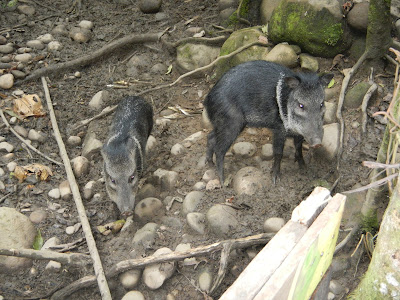The day before I leave for the Amazon I
thought I should follow through on my promise and post the second
installment in my now world renowned series “Hot Tips for Ecuador”.
So, without further ado, here goes Quito: part 2.
1.) Danger, Volcanoes! Ecuador and
Quito lie in the Pacific Ring of Fire. The whole country therefore is
spotted with active volcanoes, ready to blow at any moment. In fact,
right next to the resort town of Banos, a volcano called Tungurahua
is erupting as I write this. Quito is shouldered by an active
volcano, Pichincha, just about a mile outside the city. And if one of
the big ones like Cotopaxi were to erupt, it could completely
devastate Quito with a lahar, pyroclastic flow, or in the worst
case, a sideways eruption like Mount Saint Helens. At the very least
Quito would be buried in ash; since the 1980s ash has fallen twice in
Quito from volcanic eruptions in other parts of the country. So these
volcano warning signs are no joke, although they are pretty funny.
 |
| Volcanoes are no laughing matter, but the drawing on this sign definitely is. |
2.) I'm huge in Ecuador! I've never
considered myself tall. I'm 6'1”, by my standards, this is slightly
above average in the States. In Ecuador however, I'm a giant.
Ecuadorians, as a people, are very very short, I would say the men
average 5'7” to 5'8” and the women even shorter. And this isn't
just a generalization; in my two months here I honestly have yet to
see a single local who is taller than me. When I'm on a crowded metro
bus, I can see over everyone by a good four inches. This also means,
however, that Ecuador was not built for the tall. I'm constantly
having to duck or bow my head and several times I have smacked my
head on the bars you hold onto in the bus. Just a few days ago I
climbed on to a bus as it lurched forward, causing me to slam my head
against the bar and fall flat on the floor, that one left me with a
nice bump and some bloody hair. So if you're tall and planning a trip
to Ecuador, enjoy the view, but watch you head.
3.) All I want is a hot shower. The
house we're living in now does not have a properly functioning
shower. The water pressure is deplorable, and the water is luke warm
at best... freezing cold at worst. So we've come up with the very
third world solution of filling buckets with hot water from the tap
and pouring it over ourselves to “wash up”. I have also had the
extraordinarily bad luck of not getting a good hot shower at any of
the six different hostals I have stayed at so far. I can only hope
things improve. The lesson here of course is even in a decently
developed country even the basics can be left behind.
 |
| Me washing my hair in the sink. |
4.) Save the neck for me! This is a
quote from the classic family movie “Christmas Vacation” with
Chevy Chase. And I can now say that I've eaten a chicken neck... and
much, much more. In Ecuador it is beyond rude not to clear your
plate. You finish your food, only take what you are going to eat, and
eat what is given to you. This is a part of the culture that looks
very poorly upon waste. For fruits this means juicing whatever is
rotting, it also means not keeping very many fresh vegetables in the
house. For meats this means using the whole animal, the Whole
animal. Here are a few of the choice animal parts that I've eaten so
far:
Chicken Neck- actually very good, a
surprising amount of meat.
Pork Skin- Kind of fatty and chewy at
the same time, not bad
Chicken Kidney- Kind of like eating a
sponge, not my favorite
Liver- It's liver, not too exciting,
it's good if you prepare it right
Chicken Feet- Pretty much just skin and
tendons
Cow Stomach- Really, really chewy, with
no taste, I'm not a fan
Of course this just scratches the
surface. I have yet to try such classics as tripe (intestines), or
brains, not to mention the many things I can't even identify. But
whatever it is, if you are served food, you had better eat it, all of
it.
 |
| A yummy cow head soup from Otavalo, teeth included. |

























































